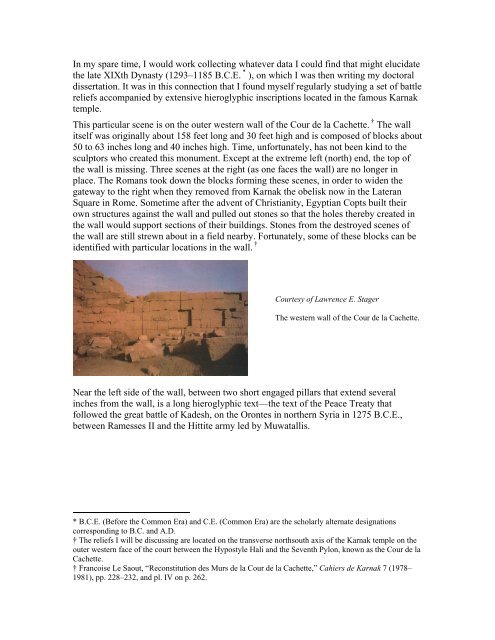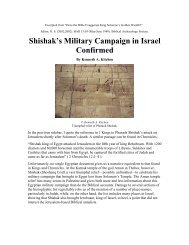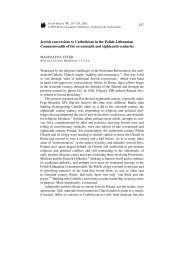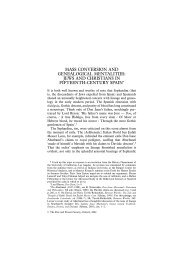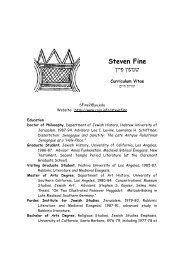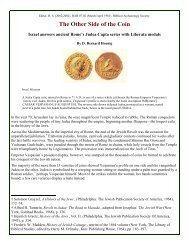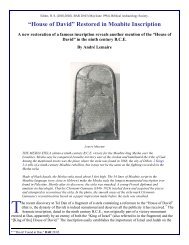3200-Year-Old Picture of Israelites Found in Egypt
3200-Year-Old Picture of Israelites Found in Egypt
3200-Year-Old Picture of Israelites Found in Egypt
Create successful ePaper yourself
Turn your PDF publications into a flip-book with our unique Google optimized e-Paper software.
In my spare time, I would work collect<strong>in</strong>g whatever data I could f<strong>in</strong>d that might elucidate<br />
the late XIXth Dynasty (1293–1185 B.C.E. * ), on which I was then writ<strong>in</strong>g my doctoral<br />
dissertation. It was <strong>in</strong> this connection that I found myself regularly study<strong>in</strong>g a set <strong>of</strong> battle<br />
reliefs accompanied by extensive hieroglyphic <strong>in</strong>scriptions located <strong>in</strong> the famous Karnak<br />
temple.<br />
This particular scene is on the outer western wall <strong>of</strong> the Cour de la Cachette. † The wall<br />
itself was orig<strong>in</strong>ally about 158 feet long and 30 feet high and is composed <strong>of</strong> blocks about<br />
50 to 63 <strong>in</strong>ches long and 40 <strong>in</strong>ches high. Time, unfortunately, has not been k<strong>in</strong>d to the<br />
sculptors who created this monument. Except at the extreme left (north) end, the top <strong>of</strong><br />
the wall is miss<strong>in</strong>g. Three scenes at the right (as one faces the wall) are no longer <strong>in</strong><br />
place. The Romans took down the blocks form<strong>in</strong>g these scenes, <strong>in</strong> order to widen the<br />
gateway to the right when they removed from Karnak the obelisk now <strong>in</strong> the Lateran<br />
Square <strong>in</strong> Rome. Sometime after the advent <strong>of</strong> Christianity, <strong>Egypt</strong>ian Copts built their<br />
own structures aga<strong>in</strong>st the wall and pulled out stones so that the holes thereby created <strong>in</strong><br />
the wall would support sections <strong>of</strong> their build<strong>in</strong>gs. Stones from the destroyed scenes <strong>of</strong><br />
the wall are still strewn about <strong>in</strong> a field nearby. Fortunately, some <strong>of</strong> these blocks can be<br />
identified with particular locations <strong>in</strong> the wall. †<br />
Courtesy <strong>of</strong> Lawrence E. Stager<br />
The western wall <strong>of</strong> the Cour de la Cachette.<br />
Near the left side <strong>of</strong> the wall, between two short engaged pillars that extend several<br />
<strong>in</strong>ches from the wall, is a long hieroglyphic text—the text <strong>of</strong> the Peace Treaty that<br />
followed the great battle <strong>of</strong> Kadesh, on the Orontes <strong>in</strong> northern Syria <strong>in</strong> 1275 B.C.E.,<br />
between Ramesses II and the Hittite army led by Muwatallis.<br />
* B.C.E. (Before the Common Era) and C.E. (Common Era) are the scholarly alternate designations<br />
correspond<strong>in</strong>g to B.C. and A.D.<br />
† The reliefs I will be discuss<strong>in</strong>g are located on the transverse northsouth axis <strong>of</strong> the Karnak temple on the<br />
outer western face <strong>of</strong> the court between the Hypostyle Hali and the Seventh Pylon, known as the Cour de la<br />
Cachette.<br />
† Francoise Le Saout, “Reconstitution des Murs de la Cour de la Cachette,” Cahiers de Karnak 7 (1978–<br />
1981), pp. 228–232, and pl. IV on p. 262.


